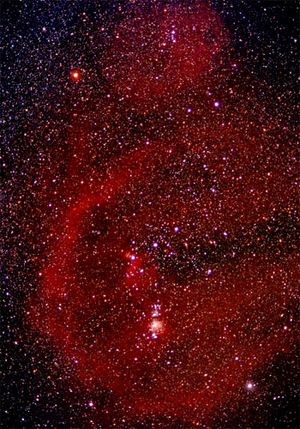Orion complex facts for kids
The Orion complex is a giant area in space where new stars are born. It's found in the constellation of Orion, which you can see in the night sky.

This amazing complex is made up of many bright nebulae (giant clouds of gas and dust), dark clouds, and groups of young star clusters. It's super far away, about 1,500 to 1,600 light-years from Earth! That's a really long distance! The complex itself is also huge, stretching hundreds of light-years across.
You can see some parts of this complex, like the famous Orion nebula, with just your eyes. Other parts can be seen using binoculars or small telescopes.
The Orion complex is very important because of its massive size. It's also one of the busiest places in the night sky where new stars are forming. Inside it, scientists have found protoplanetary disks, which are flat spinning clouds of gas and dust that can turn into planets. There are also many very young stars. The complex glows brightly in infrared light because making stars creates a lot of heat. This complex includes different kinds of space clouds, like dark nebulae, emission nebulae, reflection nebulae, and HII regions.
Amazing Clouds in the Orion Complex
Here are some of the most well-known nebulae (space clouds) that are part of this huge complex:
- The famous Orion nebula, also known as M42.
- M43, which is actually a part of the Orion Nebula.
- IC 434, which contains the cool Horsehead Nebula.
- The Horsehead nebula, which looks like a horse's head!
- Barnard's Loop, a giant loop-shaped cloud.
- M78, a reflection nebula that shines by reflecting light from nearby stars.
- NGC 1999.
- NGC 2175, which includes:
- Various other Orion molecular clouds (these are very dense clouds of gas and dust).
- The Flame nebula (NGC 2024), which looks like a flame.
Also, a group of very hot, giant stars called the Orion OB1 Association is part of this complex. These stars are of spectral types O and B, which means they are some of the hottest and brightest stars in the universe.
Images for kids
-
A labeled map of the Orion molecular cloud, with images taken by IRAS and various telescopes that mapped CO in this part of the sky.
See also
 In Spanish: Complejo molecular de la nube de Orión para niños
In Spanish: Complejo molecular de la nube de Orión para niños



